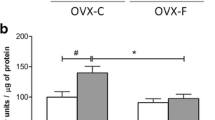Abstract
Changes in serum levels of calcium (Ca), phosphorus (P), Ca phosphate, alkaline phosphatase (AKP), and osteocalcin (BGP) were assessed in a model of type 2 diabetes in 8-weeks-old Sprague–Dawley rats. Throughout the study, the animals in Group A consumed high-carbohydrate, high-fat diet and were administered two intraperitoneal injections of streptozocin (STZ) at 4 (25 mg/kg) and 8 (40 mg/kg) weeks after diet initiation. Animals in Group B received similar diet but intraperitoneal injections with citrate buffer. The control group rats (Group C) were fed normal diet and received citrate buffer injections. The Ca levels in Group A were significantly decreased at 12 and 16 weeks, while P levels were significantly lower at 8, 12, and 16 weeks after the first STZ injection (p < 0.05 vs. Groups B and C). The Ca phosphate levels in Group A were significantly lower at 16 weeks (p < 0.05 vs. Groups B and C). There was a discrepancy in kinetics of AKP and BGP levels in Group A, such that the former showed a significant surge at 8 weeks (p < 0.05 vs. Groups B and C) followed by a decline at 16 weeks (p < 0.05 vs. Groups B and C), while the levels of the latter consistently decreased and became significantly decreased at 12 and 16 weeks (p < 0.05 vs. Groups B and C). In conclusion, these findings may lead to better understanding of the pathogenesis of osteoporosis in diabetic rats.
Similar content being viewed by others
Abbreviations
- STZ:
-
Streptozocin
- BGP:
-
Bone gla-containing protein (osteocalcin)
- AKP:
-
Alkaline phosphatase
References
Levin, M. E., Boisseau, V. C., & Avioli, L. V. (1976). Effects of diabetes mellitus on bone mass in juvenile and adult-onset diabetes. New England Journal of Medicine, 294, 241–245.
Arikan, S., Tuzcu, A., Bahceci, M., Ozmen, S., & Gokalp, D. (2012). Insulin resistance in type 2 diabetes mellitus may be related to bone mineral density. Journal of Clinical Densitometry, 15, 186–190.
Akin, O., Gol, K., Akturk, M., & Erkaya, S. (2003). Evaluation of bone turnover in postmenopausal patients with type 2 diabetes mellitus using biochemical markers and bone mineral density measurements. Gynecological Endocrinology, 17, 19–29.
Al-Maatouq, M. A., El-Desouki, M. I., Othman, S. A., Mattar, E. H., Babay, Z. A., & Addar, M. (2004). Prevalence of osteoporosis among postmenopausal females with diabetes mellitus. Saudi Medical Journal, 25, 1423–1427.
Tuominen, J. T., Impivaara, O., Puukka, P., & Ronnemaa, T. (1999). Bone mineral density in patients with type 1 and type 2 diabetes. Diabetes Care, 22, 1196–1200.
Oei, L., Zillikens, M. C., Dehghan, A., Buitendijk, G. H., Castano-Betancourt, M. C., Estrada, K., et al. (2013). High bone mineral density and fracture risk in type 2 diabetes as skeletal complications of inadequate glucose control: The Rotterdam study. Diabetes Care, 36(6), 1619–1628.
Barrett-Connor, E., & Kritz-Silverstein, D. (1996). Does hyperinsulinemia preserve bone? Diabetes Care, 19, 1388–1392.
Wang Q, Zhang B, Xu Y, Xu H, Zhang N (2013) The relationship between serum osteocalcin concentration and glucose metabolism in patients with type 2 diabetes mellitus. International Journal of Endocrinology. doi:10.1155/2013/842598.
Qi, Z., Yu, C., & Wang, M. (2005). Metabolic characters of biochemistrv in rats with avascular necrosis of head induced by diabetes. Chinese Journal of Clinical Rehabilitation, 9, 61–63.
Cui, Y. (1996). Rabbit of bone fracture and bone defect content in serum BGP dynamic observation. Lanzhou Medical College, 22, 57.
Chang, X., Hou, Z. M., Yasuaki, S., Tomoo, T., & Akira, Y. (2005). Quantitative study of alkaline phosphatase and osteocalcin in the process of new bone. Hua Xi Kou Qiang Yi Xue Za Zhi, 23, 424–426.
Lee, N. K., Sowa, H., Hinoi, E., Ferron, M., Ahn, J. D., Confavreux, C., et al. (2007). Endocrine regulation of energy metabolism by the skeleton. Cell, 130, 456–469.
Author information
Authors and Affiliations
Corresponding authors
Additional information
Lin Xiao and Chen Xu contributed equally to the manuscript and should be considered co-first authors
Rights and permissions
About this article
Cite this article
Xiao, L., Wang, X.M., Yang, T. et al. Changes of Serum Osteocalcin, Calcium, and Potassium in a Rat Model of Type 2 Diabetes. Cell Biochem Biophys 71, 437–440 (2015). https://doi.org/10.1007/s12013-014-0220-1
Published:
Issue Date:
DOI: https://doi.org/10.1007/s12013-014-0220-1




